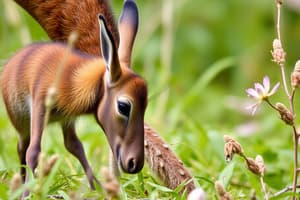Podcast
Questions and Answers
What is the primary reason the speaker disliked sandboxes as a child?
What is the primary reason the speaker disliked sandboxes as a child?
- Seeing sandboxes full of debris and trash
- Encountering aggressive children in the sandbox
- Discovering sandboxes filled with antlions (correct)
- Finding sand too hot to play in
What is the nature of the relationship between barnacles and whales?
What is the nature of the relationship between barnacles and whales?
- Mutualistic, providing benefits to each other
- Parasitic, harming the whale while benefiting from the relationship
- Predatory, preying on the whale for food
- Commensal, benefiting from whale's movement while neither helping nor harming the whale (correct)
What is the characteristics of antlion larvae?
What is the characteristics of antlion larvae?
- They build nests for shelter
- They have a symbiotic relationship with acacia trees
- They have wings for flying
- They inject enzymes into ants to consume their juices (correct)
How do antlion populations change in relation to ant populations?
How do antlion populations change in relation to ant populations?
Flashcards are hidden until you start studying
Study Notes
- Speaker disliked sandboxes as a child due to discovering sandboxes filled with antlions.
- Antlions are insects with two forms: adult and larvae.
- Antlion larvae have mandibles and create sand pits to trap ants, injecting enzymes to consume ant's juices.
- Antlions are predators of ants.
- Antlion populations increase when ant populations increase, but decrease if ant population is depleted.
- Antlions may compete with other antlions and other species for food.
- Antlions can be prey for birds.
- Some species of trees, like acacia, have symbiotic relationships with ants through hollow thorns for housing and nectar.
- Acacia trees benefit from ants' protection.
- Barnacles have a commensal relationship with whales, benefiting from whale's movement while neither helping nor harming the whale.
- Ecological relationships impact populations of various species and scientists continue to study new relationships.
Studying That Suits You
Use AI to generate personalized quizzes and flashcards to suit your learning preferences.




